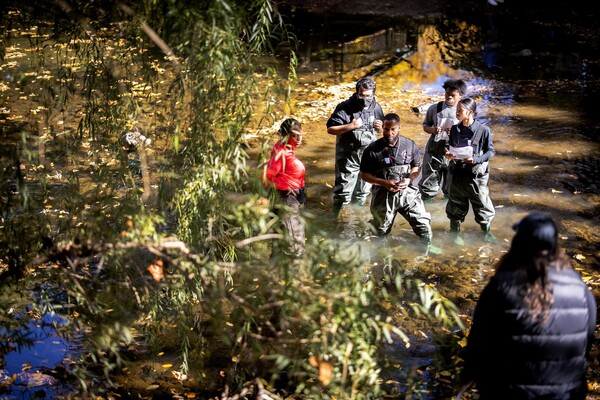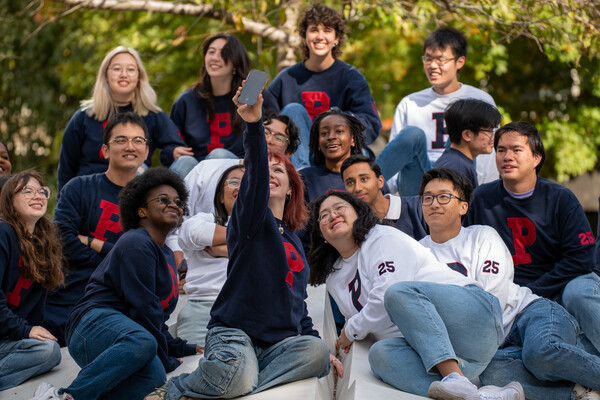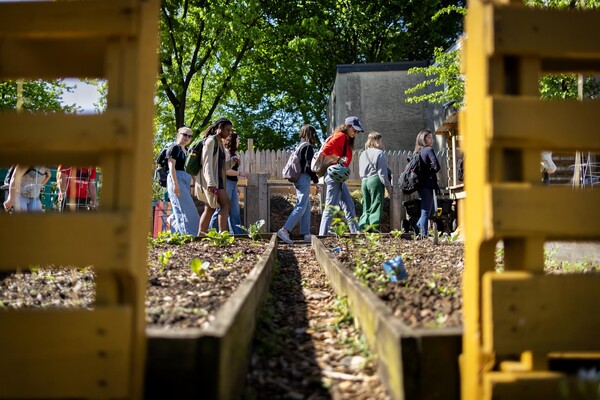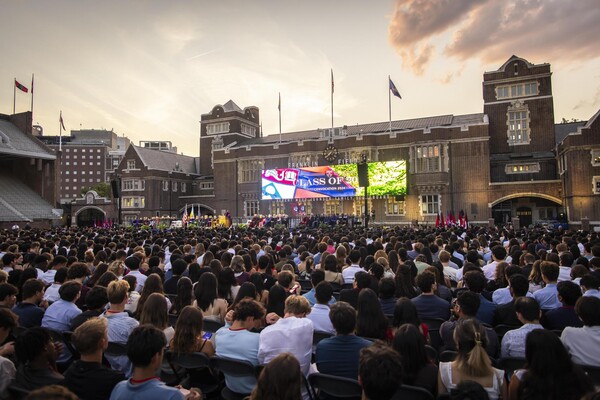"To see that horde of people coming over the bridge with all the flags and pipers is just spectacular"
Edwin Ledwell in front of Sansom Place West (formerly Graduate Tower B), one of the high-rise dormitories whose construction he oversaw in the 1970s.
Photo by Daniel R. Burke
EDWIN LEDWELL
Position:
Chief marshal,
Commencement
Length of service:
30 years, from 1968 to 1997
Other stuff:
Crazy about his grandkids and travel; just returned from Burgundy; Vienna's next.
Considering the number of Penn graduation ceremonies in his immediate family (five), Edwin Ledwell would be well-versed in the commencement procedure even if he hadn't been a marshal for 30 years.
Two years after he began his job as Director of Residence in the fall of 1968, Ledwell was drafted to assist in the ceremonies then held at the Civic Center. As he rose over the years, he supervised the building of Superblock and held positions in the Provost's Office and the athletic department, along with a seven-year stint teaching a management course at Wharton. Even after his retirement in the fall of 1997, Ledwell has made sure to don his robe and beefeater's hat each spring to lead a fresh crop of graduates from Hamilton Village, down Locust Walk, through a few hairy turns, across a busy 33rd Street and into the real world.
Q. What does a marshal do?
A. Well a marshal is basically responsible for moving the student procession in as orderly a manner as possible.
Q. So do you use cattle prods...?
A. Cattle prods and, well, gentle persuasion. That's about all you can do. You seat them and make sure as best as you can that they are properly attired. They are supposed to have all the right academic costume. Things have since become a little more lax in recent years because people are putting things on their caps. Our original idea that students ought to be completely clean has kind of gone out the window. Like balloons. How can you stop all the balloons?
And it's also seating, seeing that they get to their destination, and as much as possible we try to keep them in an orderly procession. We try to relieve them of their bottles in Hamilton Village by saying here's a jitney, we'll keep your champagne on ice and you can pick it up down at Franklin Field after the ceremony.
Q. Does that tend to work?
A. It's not heavily used. When we originally started we had the ceremony in the Civic Center. It was rather a small group of marshals because all we had to do was assemble them in the basement and move them up from the two wings and come in and everything was pretty well taken care of.
An idea of how small it was is that the first year I attended, Molly Harnwell, who was the president's wife, was hostess at a dinner [for all the marshals] at the Button Club on, I believe, East River Drive. But now the numbers have grown to a hundred and fifty.
All are not involved with the student procession. A lot of them are [involved] mostly in the academic and alumni and the honorees. The so-called chief marshal is really the chief marshal of the student procession, which runs about 60 or 70 marshals.
Q. How many were there when you started?
A. When I started it was around 15 or 20. The original, the first of the marshals when I came here was Craig Sweeten. Now that will mean something to some people around here. And Ed Lane, who recently passed away, was his number one assistant. He was a grand old gentleman. He was the kind of person who could say to you, "Come on, be a part of the commencement activity, it's a wonderful thing to do."
We've had a number of people come through and, as I say, I can't even remember when I took on the title. I think it was in 1975. Because I remember I got my MBA in 1974. When they said all MBA candidates stand I was able to stand up in the marshals' group. You know, I believe that was the year President Ford was here.
Q. How was the speech?
A. Let's see...I want to be diplomatic about it. Memorable but not inspiring. That was the kind of thing where you had your picture taken with some of the honorees and that was exciting. At that time I was not the chief marshal, so it must have been a couple years after that.
Q. What duties did you then take on?
A. When it really gets down to it, most of the work is done by the Office of the Secretary. What I help assist with is the working up of the list of marshals and help convince people to participate, and make sure everyone knew what their duties were.
The key to our operation is get people coming through in columns of four so we can promptly seat people as fast as we can. Of course coming the distance from Hamilton Village to Franklin Field, it's hard to keep people in line, particularly this morning when they're exuberant and enjoying themselves and looking for mom and pop along the way.
Q. Have you ever lost one along the way?
A. Well actually they mix themselves up. One of the little tricky parts is to say, How can we start the procession at Hamilton Village, come across the bridge and then not have a long wait before the faculty starts clapping. And that's really exciting. To see that horde of people coming over the bridge with all the flags and pipers is just spectacular.
I believe it's the ultimate experience if you work at a university. Otherwise, why are we all here?







